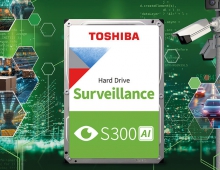
Toshiba Develops 60GHz Receiver Technology Using CMOS Device
Toshiba has announced new technology that opens the way to manufacturing powerful ICs for the millimeter-waveband.
The new fabrication process uses a low-cost CMOS process to achieve high-speed integrated wireless communications over short distances, and will support development of consumer applications. Toshiba unveiled the technology on June 15 at Session 17-1 of the 2007 Symposia on VLSI Circuits, in Kyoto, Japan.
Millimeter-wave communication offers high-speed wireless communication in the 60GHz band, a frequency over ten times higher than that of wireless LAN. While communication distances are limited to a few meters due to the nature of the wave, the wide bandwidth of the signal allows data transfers at a rate of more than 1 gigabit a second. In Japan, the U.S. and Europe, frequencies around the 60GHz band are allocated to unlicensed equipment. In the case of Japan, the allocated range is 59 to 66GHz, a width of 7GHz. As a result, millimeter-wave communication is increasingly seen as a solution for short distance transmission of high-speed data.
60GHz IC for millimeter-wave communication have been fabricated with gallium arsenide (GaAs), which is more expensive than CMOS IC. Millimeter-wave GaAs IC also require separate integration on the module of an antenna and a synthesizer, which can not be fabricated with GaAs process technology, plus additional components, including bonding wire and costly ceramic board. This further increases cost and chip die size.
With advances in process technology, complementary metal-oxide semiconductor (CMOS) technology is now approaching a level where it is applicable to the millimeter waveband. This has prompted universities and companies around the world to promote development of CMOS IC, as CMOS devices enjoy the advantages of a low cost silicon substrate, and are the most widely used devices in consumer and industrial digital ICs. In addition, multiple functions, including a digital signal processor can be formed directly on the chip.
Toshiba has realized a 60GHz CMOS receiver chip for the millimeter-wave band. It integrates an on-chip antenna, LNA, a mixer with a preamplifier and a phase-locked loop (PLL) synthesizer in a die that is only 1.1mm x 2.4mm without pad area. Application of 90nm process technology supports high levels of integration and achieves a performance close to that of much more complex and expensive GaAs devices. A fully differential circuitry improves signal quality, as it achieves noise-resistant features suited to millimeter-wave IC application. Optimization of element structure and wiring structure restrain internal noise, and contributes to realizing stable operationthe major issue to overcome for millimeter-wave CMOS IC.
Millimeter-wave communication offers high-speed wireless communication in the 60GHz band, a frequency over ten times higher than that of wireless LAN. While communication distances are limited to a few meters due to the nature of the wave, the wide bandwidth of the signal allows data transfers at a rate of more than 1 gigabit a second. In Japan, the U.S. and Europe, frequencies around the 60GHz band are allocated to unlicensed equipment. In the case of Japan, the allocated range is 59 to 66GHz, a width of 7GHz. As a result, millimeter-wave communication is increasingly seen as a solution for short distance transmission of high-speed data.
60GHz IC for millimeter-wave communication have been fabricated with gallium arsenide (GaAs), which is more expensive than CMOS IC. Millimeter-wave GaAs IC also require separate integration on the module of an antenna and a synthesizer, which can not be fabricated with GaAs process technology, plus additional components, including bonding wire and costly ceramic board. This further increases cost and chip die size.
With advances in process technology, complementary metal-oxide semiconductor (CMOS) technology is now approaching a level where it is applicable to the millimeter waveband. This has prompted universities and companies around the world to promote development of CMOS IC, as CMOS devices enjoy the advantages of a low cost silicon substrate, and are the most widely used devices in consumer and industrial digital ICs. In addition, multiple functions, including a digital signal processor can be formed directly on the chip.
Toshiba has realized a 60GHz CMOS receiver chip for the millimeter-wave band. It integrates an on-chip antenna, LNA, a mixer with a preamplifier and a phase-locked loop (PLL) synthesizer in a die that is only 1.1mm x 2.4mm without pad area. Application of 90nm process technology supports high levels of integration and achieves a performance close to that of much more complex and expensive GaAs devices. A fully differential circuitry improves signal quality, as it achieves noise-resistant features suited to millimeter-wave IC application. Optimization of element structure and wiring structure restrain internal noise, and contributes to realizing stable operationthe major issue to overcome for millimeter-wave CMOS IC.





















